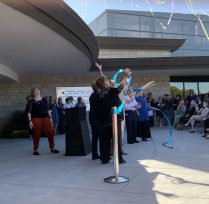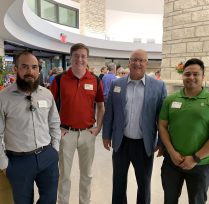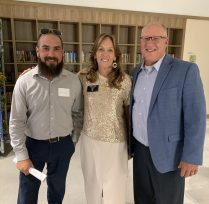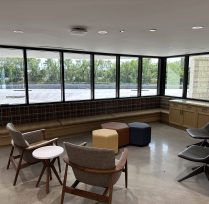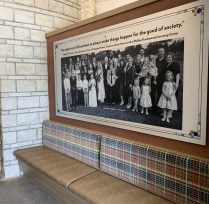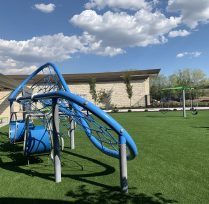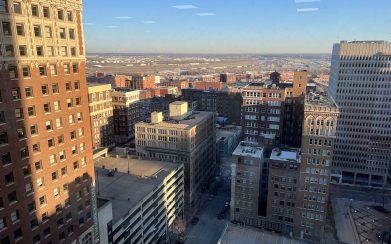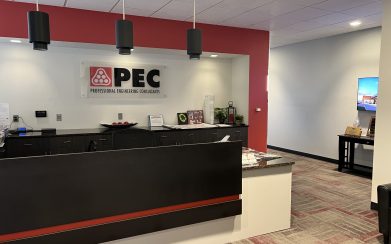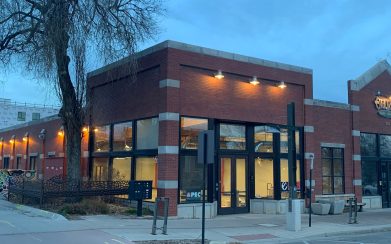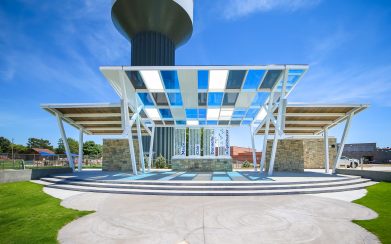Newsroom
Community Celebrates New Phillips Fundamental Learning Center Facility
With its teardrop-shaped building as the backdrop and the promise of possibilities ahead, the Phillips Fundamental Learning Center staff cut the ribbon on their new facility on October 5, 2023. Professional Engineering Consultants, PA (PEC) worked with GLMV Architecture on the project providing mechanical and electrical design as well as audio-visual services.
Founded in 2001, the Phillips Fundamental Learning Center serves children with dyslexia and their families, trains on child literacy, and advocates for the educational needs of children. The 38,750 SF facility will be able to accommodate more students and help even more families than it ever has before.
“The Phillips Fundamental Learning Center is a state-of-the-art facility that was built to help teach students with dyslexia and, to my knowledge, is the only school of its kind in the whole Midwest,” said PEC CEO Joe Surmeier, who attended the event as well. “At the ribbon cutting ceremony, I saw first-hand how community members, elected officials, and teachers from all over the region came together to celebrate a school that will bring so much benefit to Wichita as well as many surrounding states.”
The architectural design was inspired by a recovered Frank Lloyd Wright design for a learning center intended for Wichita State University (then the University of Wichita). The new facility has many distinctive features that include a circular center with three different wings expanding outward.
“The unusual architecture of the space brought a new challenge to think radial vs linear which was a fun aspect we don’t get to do every day,” said Kelby Ewert, Design Engineer in PEC’s Kansas City office.
Shaun Conway, Mechanical Team Lead in the Wichita office, also talked about how it was interesting to manage around the design. “When you walk up to the building, you obviously see how unique the design is. There are very few straight walls and square corners. Ductwork and piping are meant to be straight. So obviously, modeling ductwork and piping with the offsets and elbows to deal with all the curves of this building was a challenge. Additionally, they wanted to keep the roof looking clean, so we just had a little screened area in the middle of the roof at each pod where we could locate HVAC equipment.”
The architecture of the building wasn’t the only element that shaped the design. Auditory distractions also had to be eliminated for an optimal learning environment. “The owner needed the classrooms, especially the reading rooms, to have quiet HVAC systems,” Conway shared.
Jeremy Sanchez, Design Engineer also in Wichita, gained a better understanding about dyslexia and its complexities through designing this project. His new knowledge also impacted his approach to the project.
“From an audio-visual design standpoint, my initial approach was to emphasize the ‘visual’ aspect of the AV system, as my understanding of dyslexia was that it was solely a visual processing disorder that could be summed up as ‘A person who has trouble reading text by jumbling phrases/words/letters.’ Instinctively, I pictured large, high-resolution displays as being the upmost importance. However, during our initial program meeting with the design team, Jeanine Phillips, Executive Director at PFLC, explained that in many cases, dyslexia can be an auditory processing disorder as much as it is visual.”
Sanchez continued, “Because of that, it was imperative to provide students with the option to have their teacher’s voice be heard loud, clear, and direct if needed. As a result, we ended up incorporating a technology typically used in assisted listening systems that will allow students to download an app designed for iOS and Android. Then, by using headphones, they will have a direct/isolated audio feed of their teacher’s voice, allowing them to better focus on the content being taught while minimizing ambient room noise and other external distractions.”
When asked about the project, Jose Ramos, Electrical Engineer in Wichita office, shared, “My favorite aspects of the design were getting to work on a Frank Lloyd Wright-inspired building and getting to work on a project that will benefit the entire Wichita community. Being able to see the significance and culmination of years of work from the owners come to fruition in this building and having a hand in it is an honor.”
Projects like these are in line with PEC’s 2032 Strategic Plan which focuses on engaging communities and making them stronger. “I’m so proud of the design work and effort that our team’s put into this project which is a perfect fit to PEC’s purpose and vision,” said Surmeier.
Ewert also felt this project was an important one. “Knowing that this end user and project would help shape the future for education across the region made this project extra special.”
